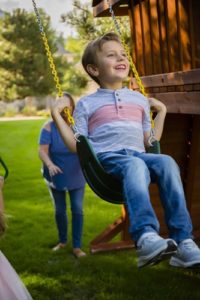Jake Grant is six years old. He is the apple of his mom’s eye, adept at sneaking out of his bed, and a lover of everything outdoors. Jake has mild to severe autism and what has made the biggest difference for him, says his mom – Jen, is early intervention.
Jake was diagnosed at the age of 2 after his preschool teachers flagged his behavior and milestones for seeming atypical. “I was so grateful to them,” says Jen. She explains that the teachers were nervous to discuss this with her, but she knew that getting an early diagnosis can help multitudes for a positive prognosis.

“That conversation was a real feel-good moment, full of acceptance and compassion,” says Jen. “I knew we lost a little bit of time due to being put on waitlists to see doctors,” she says, “but there are not enough resources, and the need is high.”
However, the typical age for an autism diagnosis is four or sometimes even later – school age. And according to many studies, the earlier, the better. Jen is seeing this reflected in her son every day.
Jake and his family “hit the ground running” when it came to getting help. “He has speech therapy and occupational therapy,” Jen explains that the game-changer was the Medicaid waiver which allowed him to enroll in Applied Behavior Analysis (ABA) and rolfing – a type of bodywork that reorganizes the connective tissues that permeate the entire body.
“As parents we want our kids to be happy, and I just knew that for a child with special needs it’s just going to be a little harder to get there,” says Jen. An interesting attribute of Jake, explains Jen, is that his diagnosis doesn’t seem to fit into any particular “mold” of autism. “He’s a sensory kid. But that means he lives for the outside, going fast (tubing and skiing are favorites), and wants to sleep with all the lights on.”

For all the positives, Jen admits that it’s hard. And some days are more difficult than others. “There are seasons of sadness, especially during well-child checkups,” she says. But the celebrations come when she sees changes and growth because of therapy. She has also learned to become an advocate for Jake.
“To me, inclusion means that all my kids go to school together,” she says. Their school suggested that Jake attend another school eight miles away to take classes with other children who have autism. “I said no. I want him to see the neighborhood kids, and for him to see his brother and sister in the hallway. “I understand there are protocols and policies in place,” she says, “but I’ve learned most have been designed to protect the school. Parents must advocate for their children.”
And on both good and ‘off’ days, there is always Kalyra, the MGA Occupational Therapist who works with Jake in the family’s sensory gym. Play-focused therapy allows Jake to move as much as he wants. Jen gets a snack, maybe even a break, and then it’s back to taking care of her kids. “MGA is an extension of my family,” she says. “And for that, I’m grateful.” Learn more about autism here.

